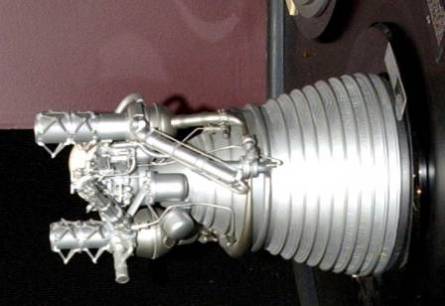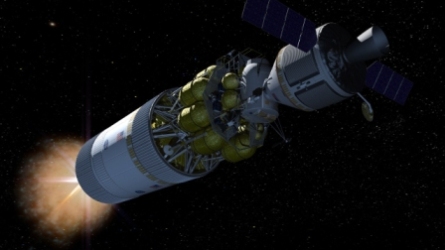It will be used as the main engine on the Orion crew vehicle launching Ares I's upper stage and the heavy lift Ares V's upper stage, which is the Earth departure stage (EDS). The X variant’s first flight test, propelling the Ares I booster's upper stage, is expected in 2012. However NASA is developing a 294,000lb (1,308kN) thrust version for the EDS and a second less powerful variant, it’s calling the J-2XD, for Ares I ISS missions.
|
|
|---|
| Above: The Ares V's upper Earth departure stage separates from the first stage. |
“The turbomachinery will be different between the J-2X and the J-2XD,” says NASA Langley Research Center researcher Lawrence Huebner, speaking at the International Astronautical Congress last week in Valencia, Spain. The J-2XD will use the same turbopumps as the J-2 Simplified (S) variant and have 274,000lb thrust. The J-2S, which had improved thrust and specific impulse, was developed in the late 1960s to replace the J-2.
The J-2XD is a risk reduction exercise, to ensure that NASA has an engine that can power the Ares I’s upper stage in time for the 2012 test flight. The J-2X will use turbomachinery from the abandoned Lockheed Martin/NASA X-33 single stage to orbit vehicle’s J-2+ engine. But that still has to be improved further for the performance the agency wants for the Ares I and V. Before the J-2X system design can begin formally the preliminary requirements review (PRR) and system requirements review (SRR) have to be completed.
|
|
|---|
| Above: The Saturn V's upper stage J-2 engine has had many variants |
NASA organized a team of Apollo programme J-2 engineers to participate in the J-2X’s PRR. They provided information on hardware evaluations, testing procedures and problem solving approaches.
The PRR, held in the second quarter of this year, gave the Alabama based Marshall Space Flight Center’s (MSFC) upper stage element engine office team confidence to move to the SRR by the fourth quarter.
NASA’s engine office now plans to build and test nearly a dozen development engines between 2006 and 2012.
In June MSFC engineers completed testing of a candidate J-2X augmented spark igniter (ASI) that uses Space Shuttle Main Engine ASI design elements, while a full-scale injector test is planned for 2007. In May 2008 the J-2X will have its critical design review and two years later the agency expects to run its first full engine systems ground test. Engine testing will also utilize a vacuum chamber to simulate the J-2X’s two operating environments, low Earth orbit and above 200,000ft.
Even if NASA succeeds in developing the turbomachinery and can abandon the J-2XD there could still be a need for two versions, for the Ares I and the Ares V EDS. The EDS J-2X will endure widely different thermal conditions compared to the Ares I’s because the EDS could be in-orbit for up to 95-days. The EDS, with its lunar surface access module (LSAM) payload, could have to wait that long for the Orion crew vehicle it will dock with because of Ares I launch delays caused by technical problems, weather issues or other events.
|
|
|---|
| Above: The Ares V's Earth departure stage boosts the LSAM and Orion for trans-lunar injection |
This delay issue is adding complexity to the EDS’s design. As the J-2X has to be restarted for the trans-lunar injection maneuver the EDS will need more helium pressurising gas for propellant tank re-pressurisation.
The EDS will also need a way of storing its liquid hydrogen (LH2) and liquid oxygen (LOX) propellant but there is no heritage system for long-term, large quantity cryogenic propulsion storage for use in-orbit. To keep the LH2 cold enough, to stop it boiling off, the EDS would need cryocoolers, but none exist.
Because of this storage issue the EDS will also need additional flight instrumentation, such as gas detection, and the related software and power supply for these subsystems.
Due to the thermal management needs of such a potentially long stay in orbit an additional propulsion system will be needed for circularization, to rotate the EDS to ensure there is even heating from the Sun’s radiation. PWR's 15,000lb-thrust LOX/LH2 common extensible cryogenic engine is being considered for this.
As well as rotation thermal control will require a combination of radiators, multi-layer insulation, heaters and possibly a pumped fluid loop for distributing heat and the avionics for controlling all this have yet to be defined.
If the radiators and related hardware does not add enough mass to the EDS already, because of its stay in orbit its design must also address protection against micrometeroid and debris impact.
Source: FlightGlobal.com


























